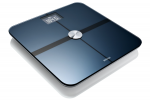Well, I’m about to embark upon a new experiment. My weight has crept back up to where it was when I first joined Weight Watchers six years ago. I peaked probably near 325 or even higher, but was around 307 when I started with Weight Watchers. I eventually trimmed down to a little over 260, but lost movitation as my efforts to go lower stalled, and of course, once you feel like you stalled, my weight slowly has crept back up to higher levels, and this morning I’m nudging in at around 303 lbs.
Yes, I’m unflinchingly telling you those numbers. Okay, I’m flinching a tiny bit. Many people gasp when they hear that number. Hey, I’m 6’4″ tall too, so it isn’t as bad as it could be. Still, I cringe a bit inside when I see that “3” at the beginning of my weight, largely because I know that it probably means that my blood pressure and cholesterol levels could use some work too.
Anywhere, there’s the setup. Here’s the new experiment: I’ve acquired a wifi enabled scale from withings.com. I blame Leo Laporte, because he mentioned he got one, and I decided that I would give it a shot. One of the interesting things about this scale is that you can set it up to echo your weight to both their own site, to Google Health, or to (gasp!) Twitter.
So, I’ve created a new twitter login called marks_mass to serve as the output for this device. Each morning I’m going to hop on the scale and get a weight + BMI reading, which will get echoed onto my twitter account (right now it seems to just be sending my weight, I’ll see if I can change that, I’m still getting acquainted with the device). And, all of my followers will be able to see what I weigh.
Here’s where you come in: if you have a reaction, positive, negative, doesn’t really matter, go ahead and respond to marks_mass. Send encouragement. Send disappointment. Send advice. I’m opening this up to harness the power of my peers to help me change my own attitudes and behavior.
Welcome to my grand experiment.
Click here if you want to see marks_mass, and if you like, you can become a follower.
Addendum:
 I should also give a brief mention to the device. It’s a really nice little gadget, much nicer than any other bathroom scale I’ve had before. It’s got a very sleek black finish and a bright display that I can read easily when you stop on it. If you step on it with bare feet, it will weigh you, and if you continue to stand, will give you a progress bar as it determines your BMI. Setup for the WiFi was similarly simple. You go to their website, download an installer for PC/Mac. You then do a one time configuration by plugging it into your PC, which pairs it to your wireless access point and gets it registered. You can then create a profile, and use it to start monitoring your weight. (All future configurations are done over the Internet.) I’m quite pleased with the device thusfar.
I should also give a brief mention to the device. It’s a really nice little gadget, much nicer than any other bathroom scale I’ve had before. It’s got a very sleek black finish and a bright display that I can read easily when you stop on it. If you step on it with bare feet, it will weigh you, and if you continue to stand, will give you a progress bar as it determines your BMI. Setup for the WiFi was similarly simple. You go to their website, download an installer for PC/Mac. You then do a one time configuration by plugging it into your PC, which pairs it to your wireless access point and gets it registered. You can then create a profile, and use it to start monitoring your weight. (All future configurations are done over the Internet.) I’m quite pleased with the device thusfar.
Addendum2: Oh, and there’s an iPhone app too.
